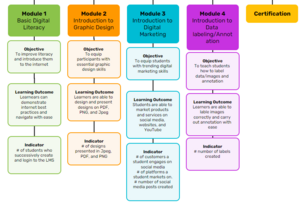CAS Digital Learning in Emergencies (2022-23)/module4-Ombinarichard
Module 4 - Richard's page
Introduction
This 12 week's training course teaches the fundamentals of digital marketing, it covers the basic elements that will equip learners with the skills required to get started on digital marketing ventures. There are quizzes, assignments and practical activities learners will need to complete to successfully graduate from the program.
Training Delivery
- 10-12 weeks
- 4 hours daily
- 5 days a week
- Delivery method - both online and classroom
- LMS - Google Classroom/Website
Training requirements
- Computers
- Stable internet
- Projector or big screen (optional)
- Whiteboard and marker pens (optional)
- Webcams (optional)
- Headphones
- Gmail email addresses (participants)
Course Goals
At the end of this course learners should be able to identify the importance of the digital marketing for marketing success, to manage customer relationships across all digital channels and build better customer relationships, to create a digital marketing plan, and defining a target group, then identifying digital channels, their advantages, and limitations, to perceiving ways of their integration taking into consideration the available budget.
Modules
Digital marketing strategy
| Day | Lesson | At the end of this lesson learners should be able to | Duration (hours) |
|---|---|---|---|
| 1 | What is digital marketing and it’s benefits |
|
2 |
| 2 | How is digital marketing done | Describe a step by step process how digital marketing is done | 4 |
| 3 | Types of digital marketing channels | Outline types of digital marketing models | 4 |
| 4 |
Digital marketing best practices |
Explain digital marketing best practices | 2 |
| 5 | What is traditional marketing
|
Describe what is traditional marketing
|
4 |
Creating an Online presence
| Day | Lesson | At the end of this lesson learners should be able to | Duration (hours) |
|---|---|---|---|
| 6 | What is an online presence
|
Describe what is an online presence
|
4 |
| 7 | How to improve online presence and online presence ethics |
|
4 |
| 8 |
|
|
4 |
Learning Resources and Tests
| Learning Resource | Resource Link | Test Link |
|---|---|---|
| Digital Marketing | https://docs.google.com/document/d/1EvmDNSAporoVRk-DFBHERQTALhyyzJiF/edit?usp=share_link&ouid=116129924220251300570&rtpof=true&sd=true | https://docs.google.com/forms/d/e/1FAIpQLScxyj3J2JFYPmOZWwpZG0o72DtlZ1jqOS7SvbXnHALcq8nF2A/viewform |
Evaluation Rubric
| Criteria | Excellent = 25% | Very Good = 20% | Satisfactory = 15% | Not Met = 5% |
|---|---|---|---|---|
| Objectives, goals & situational analysis- scene setting(25 points) | Clear and relevant objectives and goals using SMART goal setting or other business oriented method. Scene setting clearly establishes the business need for the product, service, or communications campaign. | Most objectives and goals are outlined and scene setting establishesthe business need for the product, service, or communications campaign. Some gaps or lack of clarity in scene setting. | Lack of clarity in outlining objectives andgoals and the business case for the product, service, or communications campaign not well developed, although some justification provided in scene setting | Little attempt to develop objectives and goals; poor or noattempt to develop the business case for the product, service, or communications campaign. |
| Target audience development (25 points) | Sophisticated audience development using personas or other digital marketing tool; clear identification of audience clusters and convincing argument establishing the audience need for the product, service, or campaign | Very good audience development and good use of relevant digital marketing tools. Personas used to identify audience members with some accompanying justification as to why the audience has a need for the product, service, or campaign | Satisfactory audience development with someuse of relevant digital marketing tools. Limited justification forthe audience need for the product, service, or campaign. | Little attempt at audience identification or development. Limited or no use of relevant digital marketing tools e.g. persona developers. Justification and the business case for the product, service, or campaign missing or poorly identified. |
| Digital marketing strategy (25 points) | Digital marketing strategy reflects deep analysis and critical thinking. All suggested strategies are developedand aligned with best practices. All suggestions are clearly articulated and justified. Brief conclusion summarises key highlight | Digital marketing strategy reflects high analysis and critical thinking. Most suggested strategies are developed and aligned with best practices. Most suggestions are clearly articulated and managed. Brief conclusion to the point with some key highlights summarised. | Digital marketing strategy reflects some analysis and critical thinking. Some suggested strategies are developed and aligned with best practices, but these are limited. Some strategies are clearly articulated however others could be difficultto implement. Conclusion provides a couple of key highlights | Digital marketing strategy does not reflect any analysis or critical thinking. Strategies are either missing or poorly defined and misaligned with best practices. What strategies there are could be difficult to manage or support. Limited or missing conclusion |
| Document quality and sources used(25 points) | The document is well presented, grammatically correct with a wide range of sources used and correctly acknowledged. Appropriate graphics and tables used to support the analysis | The document is generally well-presented, grammatically correct and uses a good range of sources correctly acknowledged. Some appropriate graphics and tables used to support the analysis. | The document is presented to a satisfactory standard. Some grammatical errors. Limited range ofsources used and correctly acknowledged. Limited use of graphics or tablesto support analysis. | Poorly presented with little attention tocorrect grammar. Limited sources used. Some acknowledged correctly. Limited or no use of graphics or tables to support the plan. |

